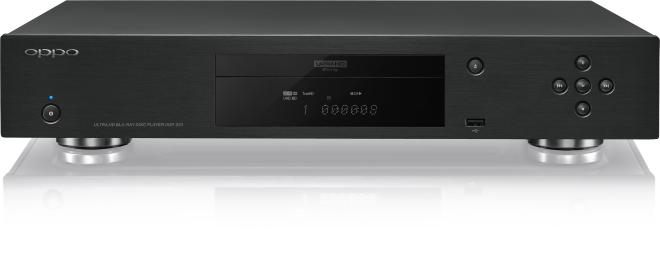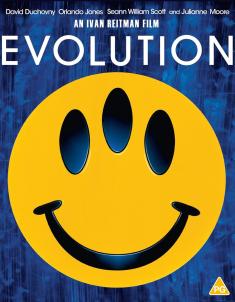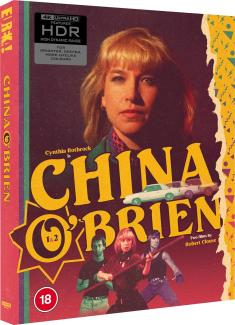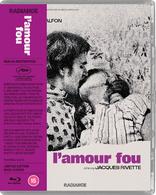OPPO UDP-203 4K Ultra HD Blu-ray Player
Overview -PROS
— Ultra-fast load times
— WiFi and DLNA connectivity
— 2 HDMI outputs (for non-4K AV Receivers)
— 1 HDMI input (for upscaling other devices)
— Best 4K HDR imagery that includes Dolby Vision
— Excellent upconverting capabilities
— Attractive home screen w/ great selection of picture settings
CONS
— Expensive 4K player
— Lack of streaming apps
— Large, hefty remote
— Some odd default settings
— Bulky, heavy player compared to others
INTRO
For longtime home theater enthusiasts, the OPPO brand seemed to have come out of leftfield and quickly grew to prominence, becoming a serious contender against the bigger, better-known companies that even neophytes soon learn of. Since its introduction in 2004 with their universal DVD player, the name has become synonymous with high-end quality and the price tag to match, a company devoted at exploiting the full capabilities of new emerging technologies and formats for the very best audio and video experience possible. And now with Ultra HD Blu-ray entering its second year, OPPO joined the 4K game last December with the awesome UDP-203 disc player.
Granted, the player didn't have the smoothest launch imaginable, encountering several hiccups and minor setbacks. Many early owners reported loud fan noise during UHD playback, issues with the player freezing or stuttering with certain discs, and HDCP device error messages due to HDMI handshake issues. As for myself, when I received my player nine months ago, it randomly froze needing a hard shutdown, received HDCP error messages on various occasions, and frequently experienced audio dropouts from the HDMI Audio Only output. As one would imagine, given the company's reputation, these issues were incredibly frustrating and disappointing.
Thankfully, as they've proven over the past decade, the company is dedicated to providing the best customer service and delivering a high-quality product that can't be beaten. Through various firmware updates, OPPO has resolved many, if not all, the issues reported by owners. And with the latest firmware update (UDP20X-46-0622) adding Dolby Vision HDR playback, making it the only machine currently on the market to do so until the LG updates its UP970 player (review coming soon), the UDP-203 player is the best, albeit relatively expensive, machine for home theaters equipped for 4K Dolby Vision HDR and the latest in object-based audio formats.
SETUP & DESIGN
OPPO disc players have not changed much since the BDP-93, sporting a black metal, lightly textured chassis that covers the top and sides. An attractive, brushed aluminum panel in the front features a power button on the bottom left corner and navigation buttons on the far right. The eject button sits directly above a USB 2.0 Input, which is quite handy when wanting to share pictures, music, or videos on the fly. Keeping to the same style as previous generations, the player's disc tray is in the center, which according to OPPO, is a custom-made loader with an optimized laser mechanism, delivering faster load times than before. When testing this, Blu-rays loaded within five to seven seconds while 4K Ultra HD disc loaded at just under ten seconds, which is incredibly fast compared to its predecessors and other, less-expensive players.
The UDP-203 also sets itself apart by moving the front panel display window to the center, just beneath the disc loader, making it somewhat reminiscent of the BDP-83 or the next evolutionary step of it. Weighing in at just under 10lbs and measuring approximately 17 x 12 x 3 inches, the player may have lost a pound or two, but the machine remains a hefty beast requiring quite a bit of space all to itself. For many, size and weight can often be good indicators of quality, and in this area, it doesn't disappoint. Under the hood, the machine is powered by the OP8591 quad-core CPU from MediaTek, which is a big move away from the excellent Marvell QDEO processor in the BDP-103 or the much-touted Darbee Edition player. However, the new customized chipset has so far proven itself to be an outstanding and incredibly reliable processor, doing a superb job of upscaling lower resolution content to 4K while handling Dolby Vision HDR without issue. Just above the video processing, we have the AK4458VN chip from AKM, a well-regarded manufacturer of high performance integrated circuits. This 32-bit DAC delivers not only the latest and greatest in multichannel high-resolution audio but also capable of 192 kHz / 32-bit PCM analog processing at low distortion levels.
In the back, audiophiles can enjoy the benefits of this when finding 8-channel analog outputs for either 7.1, 5.1 or stereo configurations. SACD enthusiasts are sure to appreciate this feature. Just below that, Trigger Input and Output are available for those with either IR or RF setups. Immediately to the left of that are an RS-232C Serial Control Port, a pair of USB3.0 inputs, and audio outputs in Optical Digital or Coaxial for backward compatibility. One of the more interesting aspects of the player is an HDMI 2.0 input, allowing users the opportunity to take advantage of the player's excellent 4K video processing capabilities when connecting an external streaming device. Right next to it are dual HDMI ports: one a 2.0 output for HDR-ready UHD TVs while the other a 1.4 port for audio only to older receivers. This is also particularly useful for owners of A/V systems that can't yet do Dolby Vision passthrough. And finally, an Ethernet LAN port can be used for connecting home servers or the internet, but the UDP-203 also comes with built-in 802.11ac Wi-Fi for easier connectivity.
I also would like to take a minute to praise the new home screen, a massive and significantly attractive improvement over previous generations. While scrolling through the seven menu options along the bottom of the screen, the backdrop alternates to various scenes of stunning natural wonders. When selecting one of those options, the scene changes to a simple light blue backdrop and white text. Under "Setup Menu," owners can find a wealth of options, most importantly the ability to customize and change output resolution to match one's television set while also changing the color space up to YCbCr 4:4:4 subsampling at 12-bit depth. Currently, 4K Ultra HD Blu-ray discs are mastered at 4:2:0 subsampling and 10-bit, but this being available is for upconverting and could possibly mean the UDP-203 is future-proof for the full capabilities of Dolby Vision. The option is also nice to have for those who haven't upgraded their HDMI cables from 10.2Gbps to 18Gbps bandwidth speeds. It is also here where owners can choose a reportedly accurate HDR-to-SDR conversion of 4K discs, which basically strips the HDR metadata from the UHD for those with older 4K TV sets or native 4K projectors. I haven't tested the feature, so I can't comment on its capabilities.
Aside from all these positives, the machine does come with a few notable, albeit rather negligible, drawbacks, starting with the remote. Being a backlit remote is, of course, a very nice feature OPPO has provided from the beginning, but the design hasn't really changed since the BDP-83, except for dedicated Netflix and VUDU buttons in the BDP-103 remote. With the UDP-203, those options have been removed because the player no longer offers such streaming options, reportedly for cost considerations. Some will probably be disappointed with this, but with 4K Dolby Vision streaming available on all (Dolby Vision enabled) television sets, the loss is, frankly, of little consequence. My bigger gripe with the remote is its rather cumbersome size and weight. While other remotes have shrunken down to the bare essentials, OPPO continues providing all the player's features with a single push of a button, which some owners may like or even prefer. However, those same options are also available by accessing the setup menu or much more without interrupting video playback, which is very nice for those with Logitech's Harmony universal remotes.
SPECIFICATIONS
From OppoDigital.com
PERFORMANCE
To test the upconverting capabilities of the player's video processor, I watched the 2004 DVD of May (a personal favorite), which is notorious for its poor resolution quality, unnaturally bright highlights, various instances of mild aliasing and sadly plagued by combing artifacts. Incredibly, and to my amazement, the UDP-203 handles the standard-def video with aplomb and even improves it, looking significantly smoother and with less visible artifacts than before. Although there remain some interlacing issues, which are inherent to the MPEG-2 encode, it is not as bad or egregious as before, and much of the aliasing is all but gone. Even better, the picture is noticeably sharper with far better resolution of the finer details in the background and foreground while facial complexions are surprisingly revealing. At the same time, the movie is a tad brighter with improved contrast levels and a slightly more vibrant color palette. Of course, there is only so much that can be done from a DVD, but the player does remarkably well with it.
Next up was King Arthur: Legend of the Sword and Ghost in the Shell (2017) on Blu-ray to see how the machine not only handles regular HD SDR but also how well it does upscaling to near 4k. The results were pretty shocking to say the least. In both instances, overall definition was so greatly improved, exposing some minor details previously missed, such as the fine stitching in the costumes worn by the knights or the creases in the jackets of the androids. In fact, the upconversion was so well done that I had to remind myself I was actually watching either movie in 1080p. Several of the blurrier moments in the King Arthur Blu-ray are noticeably sharper than before while the tiniest bits of information are more distinct in Ghost despite the diffusion photography. Of more interest is the fact that even the color palette in both films appears a tad brighter and fuller, making them solid near-4K presentations thanks to the player's video processor.
Since the release of Despicable Me and Despicable Me 2 back in early June, I've had the opportunity of enjoying Dolby Vision HDR on physical media. This is thanks largely to the fact that the UDP-203 is the only player currently on the market that plays the DV format. (At least, until LG finally releases the firmware update for their UP970.) With the promise of a brighter and wider array of colors, both animated films are simply phenomenal. Compared to their HD SDR counterparts, primaries pop with intense energy, practically oozing off the screen, making the Blu-ray almost seem dull and limited. One of my favorite moments in the first movie is Gru talking with next-door neighbor Fred and notice the true-to-life yellows of Fred's shirt bursting against a luminous blue sky and lush green grass. In the sequel, the birthday at the beginning with all the balloons and party favors should serve as perfect demo clips. The improved highlights in that same sequence also provide metallic objects with a shockingly realistic glow, and the movie comes with many examples of rich, silky blacks that are even better than the UHD.
Of course, when it comes to animated films, they're practically guaranteed — or at least, more likely — to be of reference quality, so the bigger question is how does the OPPO player do with live-action film in Dolby Vision. And the short answer is exceptional. Look no further than the 4K UHD of Power Rangers for several examples of where the DV beats out the HDR10 version. Not only are the Rangers' costumes more vibrant and colorful, there is actually more variation in the makeup work of Bryan Cranston's Zordon at the beginning of the movie, exposing what I suspect are veins that are of a darker blue shade than the rest of his body. This tiny detail is not as apparent in HDR10. Also, Rita Repulsa's sparse outfit comes with a more brilliant emerald green glow, and her golden staff seems to glisten and shine a bit more in bright, daylight exteriors. But the best scene for noting the marked improvement and the player's ability to handle it all is when the teens circle the morphing grid and an intensely blinding white light engulfs them. In Dolby Vision, the wrinkles and creases in the clothes remain distinct, and the glowing light is tighter and more controlled while retaining rich, luxurious blacks in the background. Although its HDR10 counterpart also delivers a reference quality presentation, the UDP-203 allows for a noteworthy difference in Dolby Vision.

FINAL THOUGHTS
Compared to four other 4K players I've had the pleasure of playing with, the OPPO UDP-203 is by far the best one currently on the market. It's a hefty, fully loaded beast ready to dramatically improve any home theater with its presence and capabilities. Granted, the lack of streaming apps will be off putting for some, especially with a $549.00 price tag plus shipping costs. But with such options more readily available directly from HDTVs with ARC function, the loss is hardly a drawback in my opinion. The UDP-203 more than makes up for that with a marvelous video processor that upscales HD to near-4K and dramatically improves the picture quality of standard-def DVDs. Like previous generations, the player also comes with dedicated analog audio outputs for pre/pro systems and enjoying stereo sound. But the real bonus is the UDP-203 is currently the only player on the market that's Dolby Vision HDR ready, making it the perfect machine any true audiophile and videophile will want in their home theater system.


















